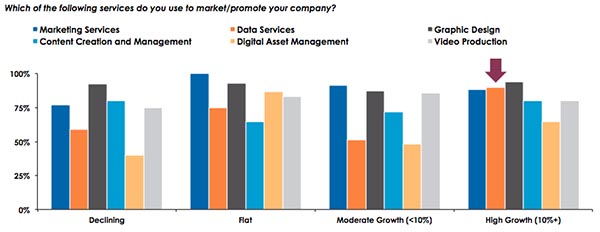- The digital revolution has created a gap between industry-leading PSPs and the technological laggards.
- Data analytics involves examining data sets with the goal of drawing a conclusion about the information they contain.
- According to InfoTrends’ survey data, 90% of high-growth PSPs are using some form of data services (e.g., preparation, cleansing, analytics) to help market their companies.
By Colin McMahon
Introduction
The digital revolution has sparked widespread change across a litany of industries. For print service providers (PSPs), it has fueled the acceleration of technology releases and improvements. This in turn has created the potential for new business models, drastic changes to workflow, and opportunities for staff reorganization. In short, the opportunities for success are numerous, but PSPs must commit to a significant amount of change and oversight.
The digital revolution has enabled high-growth PSPs—those achieving year-over-year revenue growth in excess of 10%--to dramatically outperform their peers. Industry-leading PSPS are using technology to revitalize their workflows, create new channels of client communication, and increase profits. At the other end of the spectrum, laggards are struggling with the digital revolution, haphazardly implementing solutions without a guiding plan to ensure that each new platform is properly integrated.
Nowhere is this difference clearer than with data analytics.
What is Data Analytics?
Over a decade ago, Clive Humby, a UK-based mathematician and the architect of Tesco’s Clubcard, made a rather forward-thinking statement about data. He asserted, “Data is the new oil—it’s valuable, but it can’t really be used if it’s unrefined. It must be changed into gas, plastic, chemicals, etc., to create a valuable entity that drives profitable activity. Data must be broken down and analyzed for it to have value.”
Today’s PSPs have access to more information than ever before. New digital channels like mobile apps, emails, and website interactions enable this information to be tracked, and it can then be used to analyze client behaviors and shopping patterns. On an internal basis, executives and decision-makers can determine which programs their employees use and for how long. This data makes it possible to track individuals’ specific activities as well as how much of an impact these activities have on the company’s bottom line.
Although the digital revolution holds a great deal of promise, it can only come to fruition if PSPs have the necessary software to process the surplus of information that they’re taking in. Returning to Clive Humby’s oil analogy, the data that exists on the Internet is in its rawest form. The commercial Internet is now over 20 years old, and there’s more data available than a single machine can process.
Data analytics involves examining data sets with the goal of drawing a conclusion about the information they contain. This is typically accomplished with software as the data in question is too large and too complex for a human to calculate in a timely (and reliable) manner. In the digital world, data analytics is comparable to the refinement process that turns crude oil into useable materials.
What Does Data Analytics Mean for PSPs?
Data analytics is an essential cog in a marketing strategy that can help set a PSP apart from its competitors. During a recent survey, InfoTrends examined what high-growth PSPs were doing to set themselves apart from organizations that were struggling, remaining flat, or only experiencing a small amount of growth.
All PSPs are using a mix of behaviors—such as marketing services (email, mobile, social media, cross media), graphic design strategies, and/or content creation and management—to catch the public eye. Although many of these initiatives can and will promote visibility, their effectiveness can vary wildly. Without oversight, a PSP might be committing equal resources to marketing initiatives that return two very different levels of revenue.
According to InfoTrends’ research, 90% of high-growth PSPs are using some form of data services (e.g., preparation, cleansing, and/or analytics) to help market their companies. By contrast, only 59% of declining PSPs are using data analytics.
Services Used to Promote PSPs

N = Varies; Base: PSP Respondents who offer these services to clients
Source: Winning in an Evolving Print Services Market, Keypoint Intelligence – InfoTrends
Based on the results from this survey, the PSPs that seek to make the most of their data are maximizing their chances for success in today’s digital age. In addition to increasing their visibility among clients and potential customers, high-growth PSPs are implementing tools that enable them to track and analyze each marketing initiative. With this level of preparedness, they can maximize every investment.
The Bottom Line
The days of gut-reaction thinking are over. PSPs that want to remain (or become) industry leaders must look beyond human intuition and focus on data-driven logical reasoning. Even the smartest person is no match for a complex software system that is designed to gather and interpret data from a wide variety of sources. Today’s PSPs can’t afford to base their competitive futures on decisions that are made without concrete information. To become an industry leader, it is not enough to simply gather data—this data must also be managed and processed in a meaningful way to promote growth and open up new revenue opportunities.
Colin McMahon is a Research Analyst at Keypoint Intelligence – InfoTrends. He primarily supports the Business Development Strategies and Customer Communications services. In this role, he creates and refines much of InfoTrends’ written content, including forecasts, industry analysis, and research/multi-client studies. He also assists with the editing and formatting processes for many types of deliverables.














